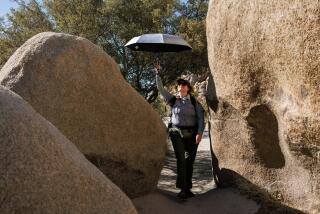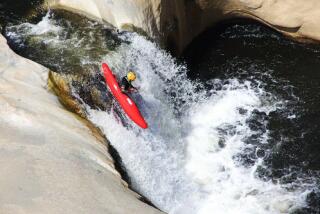Arizona: At the Grand Canyon, 683 scary stories, all true
- Share via
You don’t want Michael P. Ghiglieri writing about your next vacation.
Ghiglieri, an Arizona river guide, Vietnam vet, ecology Ph.D. and seasoned emergency medical technician, is also the co-author of “Over the Edge: Death in Grand Canyon,” an epic collection of cautionary tales from perhaps America’s most iconic national park. In the 10 years since the book’s publication, it has sold more than 250,000 copies.
Now Ghiglieri and co-author Thomas M. Myers are back with a second edition, thicker than the first. I e-mailed him 10 questions and he came back with a flood of information and anecdotes. For instance: The most common cause of death in the canyon (neither heart attack nor dehydration); one cause of death that’s never been repeated (a rattlesnake was involved); and just how much water he carries in the canyon.
Ghiglieri also emphasized that he’s not trying to scare people away from the canyon, just to jar people into staying safe and giving the canyon the respect it demands. Here’s an edited version of our exchange.
1. What’s the most common cause of death in the park?
Air crashes. All told, there have been 65 fatal crashes of various aircraft in and around the canyon, accounting for 379 victims. Of these, 259 died within the canyon, and 120 more died on the adjacent rims while trying to access or exit the airspace over the canyon. Virtually all of these were scenic flights, both commercial and private.
2. Most unusual death?
Being scared to death by a rattlesnake. No one has died due to snakebite in the canyon, though several visitors have been bitten. But in 1933, one guy, a 43-year-old prospector named Cochrane from California, was hiking down Snake Gulch (for real). He was terrified of snakes. A rattlesnake coiled up and rattled at him and made a partial strike, a feint. Cochrane leaped backward and died of heart failure, confirmed by a physician.
3. In 2011, rangers say, 21 people died in Grand Canyon National Park out of 4.3 million visitors. But how many have died in all?
It’s complicated. Some 683 people have died below the rims (thus “in” Grand Canyon) during the known history of Grand Canyon after the early 1860s. Since the canyon became a national park in 1919, the number is 653 people -- but not all of them died in the park, because the canyon extends well beyond the park boundaries to the Navajo, Havasupai and Hualapai Indian reservations and Lake Mead Recreational Area. (We did not tally deaths on the rims unless they were air crashes or homicides.)
4. How did you get the idea to first publish a book about Grand Canyon deaths?
In the summer of 1999, as I was rowing past Mile 65, I saw a guy hurrying along the shore, headed downstream. The temperature was over 100 degrees, so I stopped to offer him a ride downriver. This iron man turned out to be Dr. Tom Myers, a physician at the Grand Canyon Clinic. He told me about a book he’d just written on river trips gone wrong. I then said, “We should write a book on all the fatal events in Grand Canyon.” I knew neither of us could do this well on our own; the task was too daunting, the work too great. But together, we pulled it off.
5. What’s changed about how and why people die in the park?
Over the last decade, proportionally more people have been dying from environmental problems---mainly heat---while hiking. This is despite everything the park has tried to do via educational signs and via Preventative Search and Rescue (PSAR) work, both of which are pretty good. There were also proportionally more people dying from falls within the canyon (as opposed to those from the rims). There also have been proportionally more private boaters (non-commercial) drowning than before. And the canyon has seen an upsurge in suicide leaps from the rims. On the other hand, there have been fewer accidental falls from the rims and fewer aircraft crash deaths. Beyond the trends, however, every fatal event still seems a failure and a tragedy in one way or another, and every one still bothers Tom and me
6. Is it true that somebody once fell to his death in the canyon because he slipped while pretending to fall to his death?
Sad to say this is true. In 1992, 38-year-old Greg Austin Gingrich leaped atop the guard wall and wind-milled his arms, playing-acting losing his balance to scare his teenaged daughter, then he comically “fell” off the wall on the canyon side onto a short slope where he assumed he could land safely. As his daughter walked on, trying not to fuel her father’s dangerous antics by paying attention to them, Gingrich missed his footing and fell silently about 400 feet into the void. It took rangers quite a while to locate his body -- and to determine that his daughter was an orphan only due to his foolishness.
7. Is it true that someone once deliberately jumped to his death from a sightseeing helicopter over the canyon?
Hard to believe, but it is true. Richard Clam decided to commit suicide in this way in June of 2004. He had to wait three days to get the seat he wanted on the flight (the shotgun seat in the helicopter). He made the scenic flight, then forced his way out of the cockpit during the return. “Traumatized” understates the condition of the other passengers aboard and of the pilot. Clam plunged about 4,000 feet. It took 15 Park Service Personnel to gather the body parts. No scene in CSI was more grisly than Clam’s impact point.
8. You live in Flagstaff. How much time do you spend in the park?
Aside from several backpacking hikes, I have worked 160 two-week river trips down the Colorado in the canyon. During these trips I hiked about 25-35 plus miles on about 50 discretionary side-hikes we offer, varying in length from a few hundred yards to 18 miles each. So I’ve spent more than 330 weeks in Grand Canyon, or 2,300 days (over six years), hiking about 4,800 miles in the canyon. I average only two or three of these river trips a years lately but averaged four or five per year over most of the past 38 years. During my “biggest” year I worked 12 canyon trips for OARS Inc. and for the National Park Service as a ranger.
9. How much water do you carry?
I always carry “enough” water. I avoid “Camelbak” water systems because of their fragility and the serious consequences of their failure. The most water I ever drank in one day of hiking---and this was during a 12-mile, mid-summer hike---was just a cup short of 3 gallons. But I did not have to carry all 3 gallons at once because I was able to refill my water bottles en route at several spots during this hike. I use stainless steel water bottles these days. And I normally carry less than one gallon depending on the hike. I know every hike we do by heart and can gauge the need. It’s not only vital to carry water but also to eat salty foods while hiking -- so I do.
10. Have your habits changed since you started researching this book?
I did become far more cautious after researching and writing (and rewriting) “Over the Edge.” Now every hazard leaps out at me as if in a special effects moment in a movie. I do recognize every place in the canyon where someone has died (like seeing those little crosses along the highway), usually by name of the victim. “Oh yeah,” I find myself thinking, “this is where so-and-so died while trying to swim down to camp and drowned.” This would seem to suggest that my personal experience might be unpleasant or terrifying as a guide, but in fact it is no different than driving in dangerous traffic where you understand the consequences of screwing up or letting your attention lapse. I love the canyon -- the whitewater and the fantastic hikes -- despite the dangers they pose. And because I know those dangers well and know how to neutralize them easily, I still enjoy immensely the beauty and treasures they offer. My safety talks to clients, however, definitely have lengthened. They used to be long. Now they are longer.
More to Read
Sign up for The Wild
We’ll help you find the best places to hike, bike and run, as well as the perfect silent spots for meditation and yoga.
You may occasionally receive promotional content from the Los Angeles Times.







